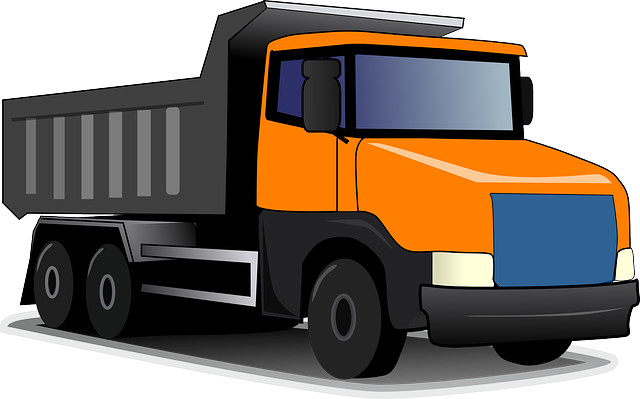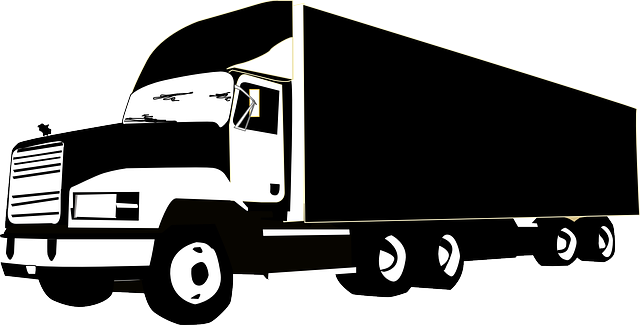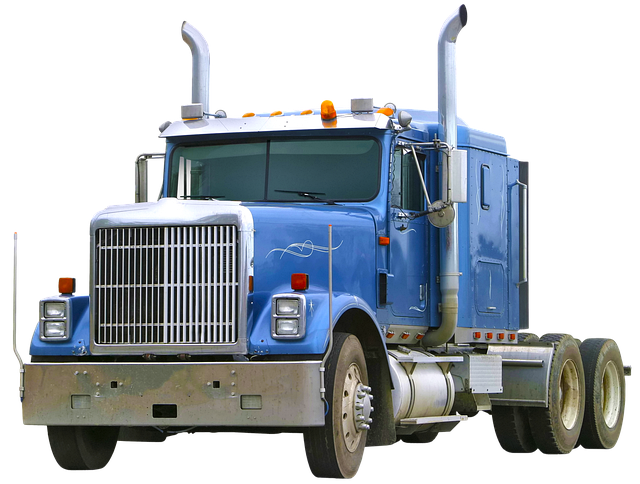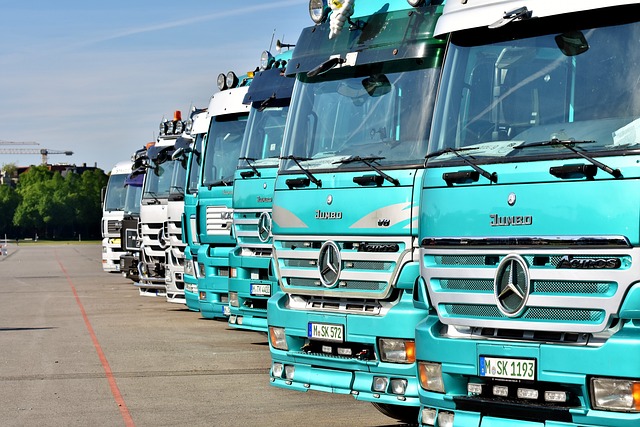Managing a small fleet of trucks requires careful consideration of insurance options to protect against wear and tear and unforeseen damages. Physical damage coverage fleet trucks, also known as truck repair insurance, is essential for mitigating financial risks associated with routine maintenance needs and unexpected events like theft, vandalism, or natural disasters. Fleet vehicle protection plans that include both collision and comprehensive coverage are key to ensuring operational efficiency by minimizing downtime due to repairs or replacements. Affordable physical damage plans are tailored to the specific needs of small fleets, offering robust financial protection without breaking the budget. Trucking fleet insurance providers offer a range of customizable policies, from collision coverage for fleets to comprehensive fleet insurance plans, designed to safeguard your investment and support business continuity. It's crucial for fleet operators to assess their risk and select a balance of comprehensive coverage with cost-effective solutions that cater to both their operational dynamics and financial constraints. By choosing an informed trucking fleet insurance partner, small fleets can navigate the complexities of fleet operations with confidence, ensuring their vehicles are protected against all types of incidental damages and ready for operation when required.
When managing a fleet of trucks, the distinction between wear and tear and covered physical damage is pivotal for maintaining operational efficiency and financial stability. This article delves into the nuances of fleet vehicle protection plans, emphasizing the importance of understanding physical damage coverage fleet trucks versus comprehensive fleet insurance. We explore the role of truck repair insurance in safeguarding small fleets, navigate the complexities of collision coverage for fleets, and offer strategic insights on implementing cost-effective small fleet damage policies that align with trucking fleet insurance options. By addressing these issues, fleets can make informed decisions to ensure their vehicles remain robust against both daily use and unexpected events.
Understanding Fleet Vehicle Protection Plans: A Comprehensive Overview of Wear and Tear vs. Physical Damage Coverage

When managing a fleet of trucks, it’s imperative to differentiate between wear and tear and covered physical damage to ensure comprehensive protection. Wear and tear coverage typically addresses the inevitable degradation over time due to repeated use, such as tire tread loss or engine component deterioration, which is an inherent aspect of fleet truck operations. On the other hand, physical damage coverage safeguards against unforeseen incidents like collisions, vandalism, or theft. Truck repair insurance tailored for fleets often includes collision coverage, which is crucial for repairing structural damages resulting from such events. Fleet vehicle protection plans can be designed to cater to both small and large fleets, offering affordable physical damage plans that align with the diverse budgetary constraints of the trucking industry.
In contrast, comprehensive fleet insurance serves as a robust shield against a wide array of risks, encompassing both wear and tear and sudden physical damages. This inclusive coverage not only ensures the longevity of the vehicles but also offers peace of mind to fleet operators. Small fleet damage policies are increasingly becoming a critical investment, as they provide financial assistance for repairs or replacements, minimizing downtime and maintaining operational efficiency. By understanding the nuances between wear and tear and covered physical damages under fleet truck insurance, businesses can make informed decisions that align with their specific needs and budgetary considerations, ultimately ensuring their fleets remain productive and profitable.
The Role of Truck Repair Insurance in Maintaining a Reliable Small Fleet

In the realm of commercial transportation, maintaining a reliable small fleet hinges on robust insurance solutions tailored to the unique needs of fleet vehicles. Truck repair insurance, encompassing fleet vehicle protection, is pivotal in safeguarding against the wear and tear that comes with frequent use and the harsh conditions faced on the road. With comprehensive fleet insurance plans, operators can rest assured that collision coverage for fleets is adequately addressed, providing financial security against unforeseen accidents and damage. This not only ensures business continuity but also contributes to the longevity of the vehicles, a critical aspect for small fleet owners who cannot afford extensive downtime or costly repairs.
Moreover, affordable physical damage plans are designed to provide coverage beyond mere cosmetic issues; they offer protection that aligns with the operational realities of fleet trucks. These policies often include provisions for both collision and comprehensive coverage, offering peace of mind against a wide array of potential damages, from natural disasters to vandalism or animal-related incidents. By investing in such insurance, small fleets can maintain their operational efficiency, minimizing the risk of operational disruptions that could stem from vehicle breakdowns or unforeseen accidents. This proactive approach to fleet truck insurance ensures that small fleet businesses can navigate the complexities of the transportation industry with confidence and resilience.
Navigating Collision Coverage for Fleets: Balancing Comprehensive Fleet Insurance with Affordable Physical Damage Plans

When managing a fleet of trucks, it’s imperative to consider the various types of insurance coverage available to protect your investment from both wear and tear and unforeseen collisions. Truck repair insurance, often termed physical damage coverage, is crucial for small fleets, offering financial protection against non-collision incidents such as theft, vandalism, or acts of nature. This form of coverage ensures that routine maintenance and repairs for these occurrences are covered, minimizing downtime and keeping your trucks operational.
In contrast, comprehensive fleet insurance is designed to address catastrophic events resulting from collisions with objects, overturned vehicles, or contact with animals. It’s a broad coverage option that aligns well with the needs of fleets, safeguarding against costly repairs or the need for vehicle replacement after an accident. To balance these comprehensive protections with affordable physical damage plans, fleet operators must carefully evaluate their exposure to risk and the specific operational dynamics of their fleet. This strategic approach enables fleets to tailor their insurance packages, optimizing coverage while maintaining budgetary constraints. Fleet vehicle protection plans that combine both collision and physical damage coverage can provide a robust shield against all types of incidents, ensuring that your trucks are ready for the road when you need them most. Trucking fleet insurance providers offer a range of policies that can be customized to fit the unique needs of each operation, allowing for flexibility and cost-effectiveness without compromising on essential coverage.
Strategies for Implementing Cost-Effective Small Fleet Damage Policies with Emphasis on Trucking Fleet Insurance Options

When crafting cost-effective small fleet damage policies, it’s crucial to consider the various types of coverage available that cater specifically to trucking operations. One of the primary options for safeguarding your fleet against unforeseen events is through physical damage coverage for fleet trucks, which typically includes truck repair insurance. This form of coverage protects your investment in the event of collisions, vandalism, or other incidents that result in damage to your vehicles, as opposed to wear and tear that occurs over time. To implement such policies without straining your budget, it’s advisable to explore comprehensive fleet insurance plans that offer a balance between protection and affordability. These plans often provide more extensive coverage than basic policies and can be tailored to the unique needs of small fleets, ensuring that fleet vehicle protection is robust yet cost-effective.
Another key aspect to consider when implementing damage policies for your fleet is the distinction between collision and comprehensive coverage options for fleets. Collision coverage is designed to address damages resulting from accidents involving other vehicles or objects. On the other hand, comprehensive fleet insurance protects against a broader range of perils such as fire, theft, natural disasters, and animal collisions. For small fleets operating on tight budgets, affordable physical damage plans can be the difference between resilient business operations and crippling financial losses due to vehicle downtime. It’s essential to assess your fleet’s exposure to various risks and select an insurance partner that understands the nuances of trucking fleet insurance, offering tailored solutions that align with your operational demands and budgetary constraints.
Operating a fleet of trucks demands strategic financial planning to safeguard against the inevitable wear and tear as well as unforeseen physical damage. This article has delved into the nuances of fleet vehicle protection plans, emphasizing the distinct nature of wear and tear versus covered physical damage. It has highlighted the importance of comprehensive fleet insurance, such as collision coverage for fleets, and the implementation of small fleet damage policies that are both cost-effective and robust. For trucking businesses, understanding the intricacies of truck repair insurance and exploring affordable physical damage plans is not just a prudent move but a necessity to ensure operational continuity and financial stability. By aligning these coverages with your specific fleet needs, you can navigate the complexities of fleet management with confidence.
